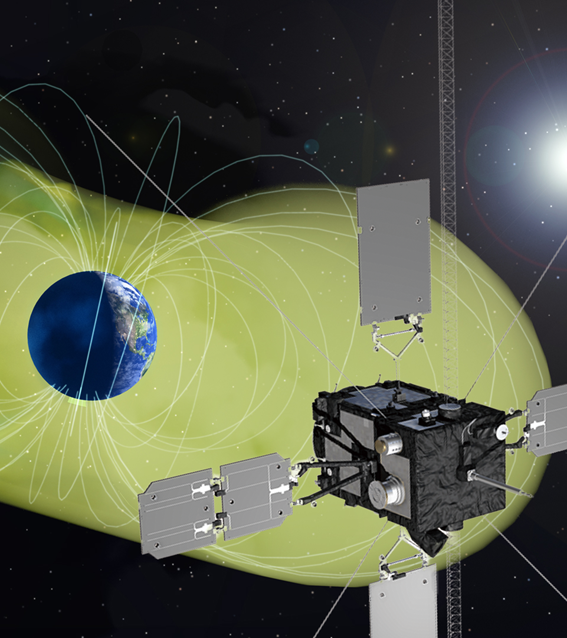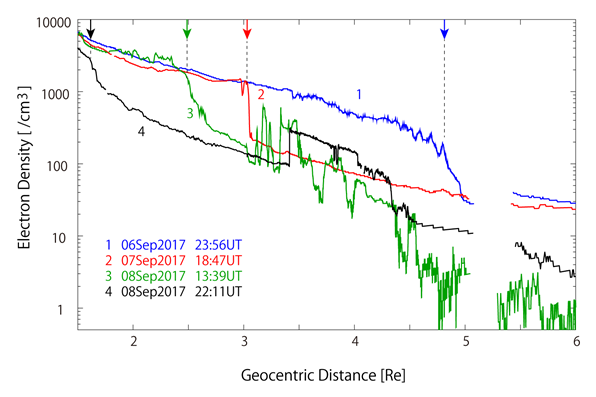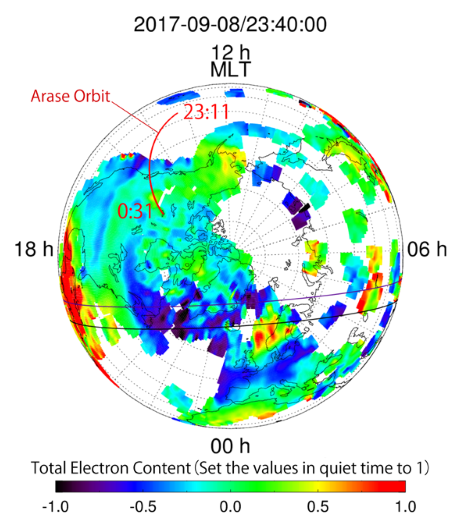|
|
|||||||||||||||||||||||||||||||||||||||
  |
|||||||||||||||||||||||||||||||||||||||
|
Paper Published: 2020/2/26 A challenge to the mystery of the severe erosion of the plasmasphereYuki Obana (Department of Engineering Science, Faculty of Engineering, Osaka Electro-Communication University)
Response of the Ionosphere‐Plasmasphere Coupling to the September 2017 Storm: What Erodes the Plasmasphere so Severely? The outer space whose height is up to several Earth radii is called the inner magnetosphere, in which, there is the plasmasphere, filled with the charged particles (plasma) that have escaped from the earth's atmosphere (Fig. 1). We analyzed the plasma wave data obtained by the Arase spacecraft, found a special event in which the plasmasphere shrinks dramatically with the occurrence of a magnetic storm, and solved the mystery of such severe erosion. Since the particles of the plasmasphere have very low energy, they are easily affected by the effect of the spacecraft charging. The data of such low-energy particles from the particle counter often include large errors. Therefore, in this study, we used the plasma wave data. The electron number densities were calculated from the frequencies of the upper-hybrid resonances, which are a kind of the plasma waves. The High Frequency Analyzer (HFA) of the Plasma Wave Experiment (PWE) onboard the Arase spacecraft observes electromagnetic field with very wide frequency range of 10 kHz to 10 MHz. Such data allow us to estimate electron density from the apogee (approximately 32,000km, electron density <1 electron / cm3) to the perigee (approximately 400 km, > 100,000 electron / cm3), throughout the orbit of the spacecraft.  Figure 1. An illustration of the Arase spacecraft and the plasmasphere (revised based on the illustration provided by the ERG Science Team)  Figure 2. Distribution of electron density in the inner magnetosphere observed by the Arase satellite. After the commencement of the magnetic storm on September 7, the plasmasphere shrank gradually.  Figure 3. A map of the total electron content in the ionosphere calculated using satellite positioning system data. The decrease in the total number of electrons (blue) is expanding to mid-latitudes around 40° latitude. Figure 2 shows the electron density before and after the magnetic storm that occurred on 7 September 2017. The horizontal axis shows the distance from the earth center, normalized by the earth radius. The blue line represents the electron density distribution before the magnetic storm on 6 September. The dense region (plasmaspheres) extend to about 5 Re (Earth Radii). The outer boundary of the plasmasphere, shown by the small arrow is identified by the sharply drop of the density and called the plasmapause. To draw this line, it takes about two hours of data in which the satellite flied from the perigee side to the apogee side, and the period shown in the figure is the start time of the observation in Universal Time (UT). After that, as shown by the red and green lines, the plasmasphere gradually shrank with the progress of the magnetic storm, and the plasmapause finally reached abaut 1.6 Re, about 4000 km of height, immediately after the main phase of the magnetic storm (black line). It is well known that when a magnetic storm occurs, the convection (a plasma flow that stirs the entire magnetosphere) occurs and the plasmasphere shrinks. However, it is unusual that the plasmapause reaches 1.6 Re. Such deep erosion is comparable to the 'Halloween storm', which is a historically major magnetic storm in October 2003. Since the September 2017 magnetic storm was a moderate magnetic storm, it is necessary to clarify the physical mechanisms that cause extreme erosion. We analyzed a large amount of GPS radio signals received by number of ground stations and created a 2D map of the total amount of electrons in the ionosphere (Figure 3). The blue area is widespread. This indicates that ionospheric electron depletion occurred from high to middle latitudes and reached about 40 degrees latitude. This corresponds to the erosion of the plasmasphere in outer space. In addition, ground magnetic field data showed that the convection electric field had been penetrating to the deepest geospace for more than 6 hours. Usually, convection gradually changes the configuration of currents in space, thus penetrated electric fields is shielded after a half or one hour from the commencement of the convection. However, in this case, some reason may suppress the shielding and caused the severe erosion of the plasmasphere in spite of the moderate magnetic storm. We simulated using the Ionosphere-Plasmasphere-Electrodynamics model developed by the research group of the University of Colorado, and found that if an electric field penetrates to mid- to low-latitudes, plasmasphere can be severely eroded. Then we conclude that the penetration of the convection electric field caused the extreme erosion of the plasmasphere during the moderate September 2017 magnetic storm. However, the reason why the convection electric field could keep to penetrate for a long time remains a mystery, and will be investigated in the future. In the inner magnetosphere, in addition to the plasmasphere, a group of higher-energy charged particles called "ring currents" and "radiation belts" exist and overlap each other. The "plasmasphere" is the group with the lowest energy, but the density is the highest, and plays an important role to control the background of the electromagnetic environment in the inner magnetosphere. Scientists expect that waves generated near the plasmapause may play an important role in accelerating and losing "radiation belt" particles that cause damage to satellites and astronauts. In other words, it is necessary to know how the plasmasphere react with each magnetic storm for the safe use of space. It is one of key issues for humanity. In the inner magnetosphere, plasma and electromagnetic fields interact, and environmental changes are complex. So it is not easy to understood the whole picture, but researchers around the world are picking up each small part and trying to draw a large picture. We are working together with cooperation and competition. |
|||||||||||||||||||||||||||||||||||||||
|
